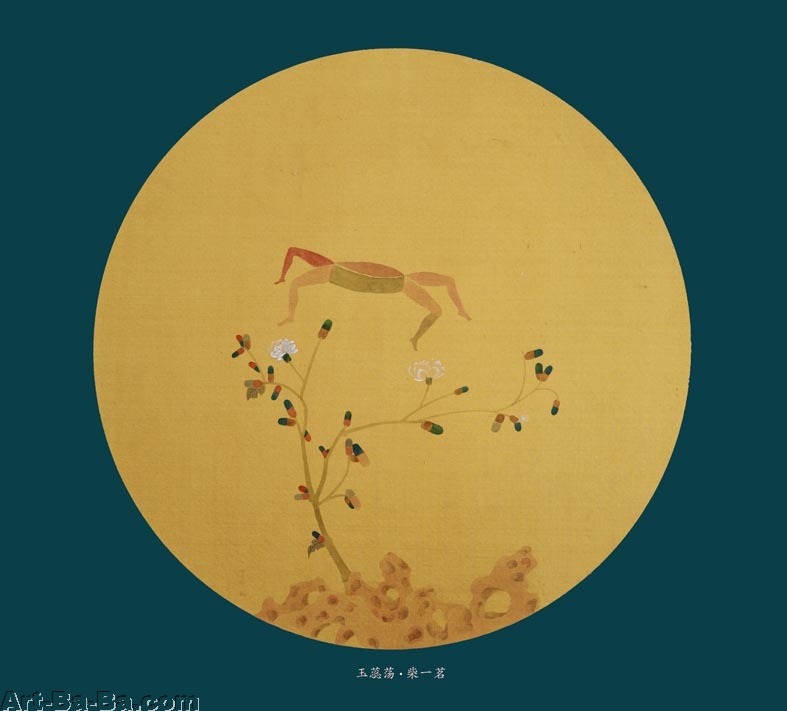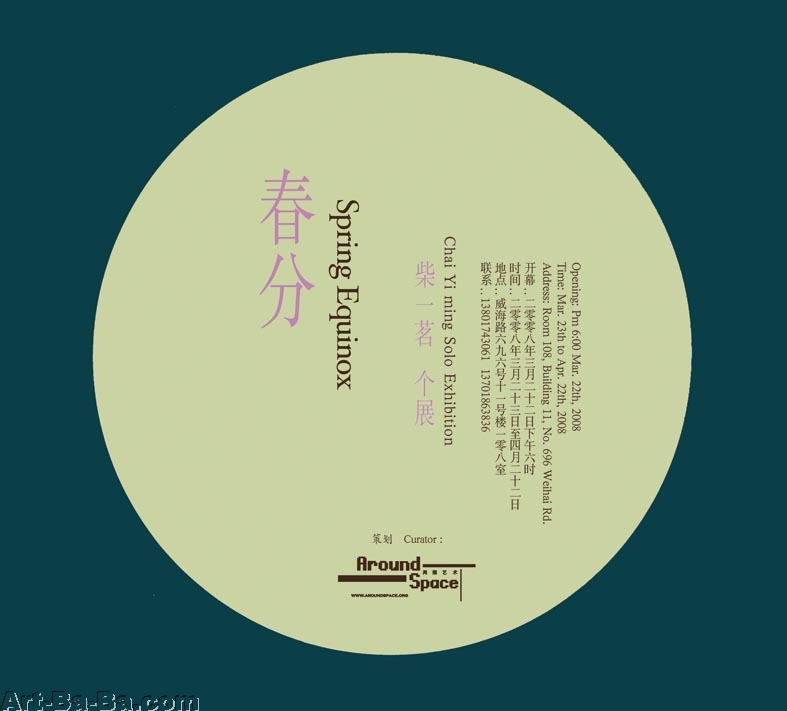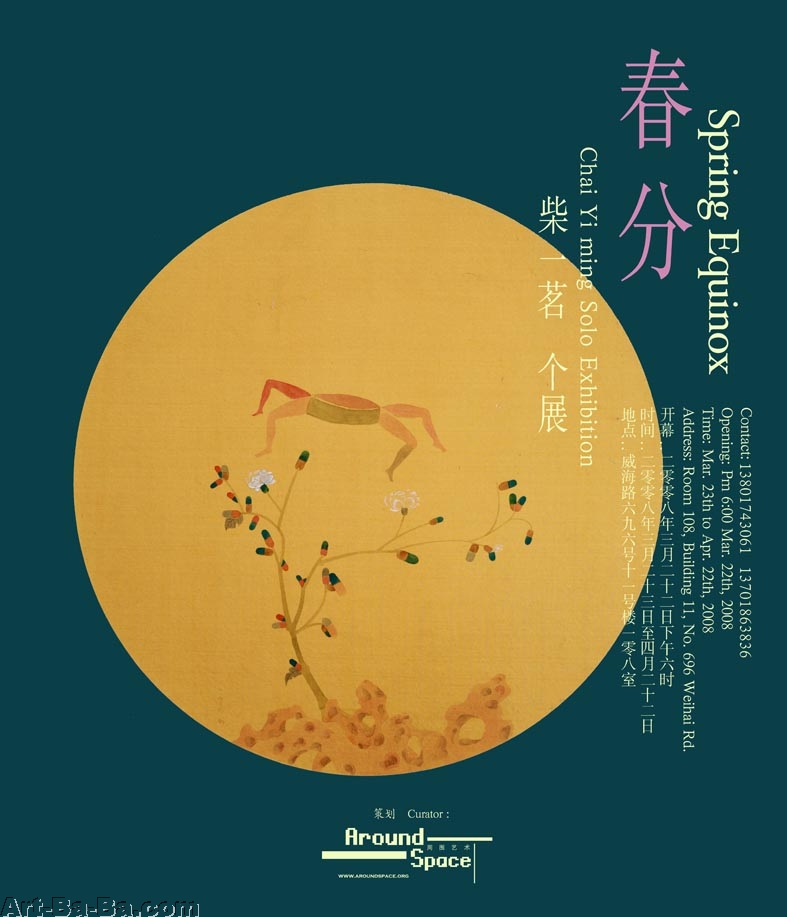“春分”—— 柴一茗个展 “Spring Equinox” ------ Chai Yi ming Solo Exihibition
发起人:aroundspace 回复数:0
浏览数:2292
最后更新:2008/03/18 01:41:48 by aroundspace
“春分”—— 柴一茗个展
??艺术家柴一茗的作品总是充满了很多“意外”。例如画面以内的荒诞且又毫无联系的具象组合,会给观者带来画面以外的神游万象般的感受。同时观者被艺术家带入他没有起点和终点的叙事和意象中。情绪的片断,思考的片断, 画面内容充满了无关联的元素,互不连接的身体部分,部分的情色描绘,幻想中的动物,花卉,以及自由飘浮的有机形体。 上述一种或几种元素的结合经常出现在他的画面中,更多时候它们会一起出现在同一幅作品中。他的绘画仿佛在创造一种机会,聚集这些让人难以置信的元素——他往往有意忽视社会符号和其他相应线索—— 而不是使用一种让人容易辨认的叙事手法。 这样做的结果是,抽象与华丽的叙事手段之间的界限变得十分模糊。??
“Spring Equinox” ------ Chai Yi ming Solo Exihibition
? Chai YI ming’s paintings manage to take on a jarring personality: the content is full of disparate elements such as disjointed body parts, erotica, fantastic beasts, flowers, and free-floating organic forms. The combination of any one of these things frequently emerges, although more often than not they all appear at once. His paintings function more as an opportunity to gather these incredulous elements—the artist usually ignores social signs and other cues—than as a means to a discernible narrative. As a result, the distinction between abstraction versus ornate story-telling is often blurred?
展览信息:
“春分”—— 柴一茗个展
策划:周围艺术
开幕:2008年3月22日下午六点
时间:2008年3月23日至4月22日
地点:威海路696号11号楼108室
“Spring Equinox” ------ Chai Yi ming Solo Exhibition
Curator : Aroundspace
Opening : Pm 6:00 Mar. 22th, 2008
Time : Mar. 23th to Apr. 22th, 2008
Address : Room 108, Building 11, No.696 Weihai Rd.
柴一茗的绘画艺术
Karen Chen (美国Fullbright访问学者)
在认识柴一茗一年以后,最近我又在他的工作室见到了他。我用不太流利的,有时候甚至是有点可笑的中文告诉他,我从来无法真正了解他的作品,因为它们包含了太多的冲突因素,但也许恰恰正是因为这一点使我对他的作品印象深刻,并为之深深着迷。
柴一茗艺术的一个现实特征便是具有某种程度上的逻辑性。 他的构图是精炼的,无论他在调色盘中使用什么颜色——通常是低调的灰色,米黄色和灰白色——他的画面从背景到前景的变化十分微小。他的作品中,没有通篇使用一种主导的技巧,没有特别突出某一样元素,一切都十分和谐,浑然一体。
但同时,他的绘画又具有一种刺激动人的特点:画面内容充满了无关联的元素,互不连接的身体部分,部分的情色描绘,幻想中的动物,花卉,以及自由飘浮的有机形体。 上述一种或几种元素的结合经常出现在他的画面中,更多时候它们会一起出现在同一幅作品中。他的绘画仿佛在创造一种机会,聚集这些让人难以置信的元素——他往往有意忽视社会符号和其他相应线索—— 而不是使用一种让人容易辨认的叙事手法。这样做的结果是,抽象与华丽的叙事手段之间的界限变得十分模糊。我所面对的这些让我感到十分迷惑,我问柴一茗,他如何做到不仅仅在于去创造这些荒诞的形象,而同时将它们并置在一个谜一样的场景中。 他毫不犹豫地回答,他的创作方式就像是一种游戏,去一个他从来想不到将会发生什么的地方。 在他看似无规律的创作中,其过程无法被人洞察,所以,同观众一样,他也在等待着看到自己的作品最终将会带来怎样的惊喜。
不管是纸本还是油画,柴一茗的作品都创造出一种多维度的张力。它们受到控制但又即兴、原始然而复杂,作品的形式趋于安静,作品所企望达到的规模却极具宏大。这些张力之间无法调和,同看到他的作品的初期相比,通常我会带着更多的问题和困惑离开。而正是这种让人迷惑的矛盾性,将昨天还是一页诡异的当代相册变成了我现在看到的,然而今天看到的一部分肢体和其他画面上的具象的并置,到了明天又可能变成了一出奇妙的戏剧。柴一茗艺术的主要力度和强度也就在于此:观众永远不可能在观看作品之后产生成型的、具体的解读,仅仅因为作品中充满了太多的对比,让人无法将他的绘画简单归结为一个概念。相反,正是这种不确定性,以及柴一茗如何创造出这种不确定性的过程,让我每次看完他的作品后都有一种全新的理解与诠释。
After more than a year since my first meeting with Chai Yiming, I had the good fortune to visit him again in his studio. In my fragmented, sometimes-hilarious Chinese, I told him that I had never quite understood his work because it evoked too many conflicts—and it was precisely because of this that made his art so memorable to me.
There is a reality to his art that speaks with a level of logic, most obvious his drawing style so precisely executed with the craftsmanship worthy of his past as a designer. His compositions are elemental to the point of sparse, and whatever colors used in his palette –often times modest grays, beige, and off-white—vary little from background to foreground. Although nothing close to an all-over technique, no one thing in particular stands out and everything blends together into a complete harmonious whole.
Yet at the same time, his paintings manage to take on a jarring personality: the content is full of disparate elements such as disjointed body parts, erotica, fantastic beasts, flowers, and free-floating organic forms. The combination of any one of these things frequently emerges, although more often than not they all appear at once. His paintings function more as an opportunity to gather these incredulous elements—the artist usually ignores social signs and other cues—than as a means to a discernible narrative. As a result, the distinction between abstraction versus ornate story-telling is often blurred. Bewildered by what I was confronted with, I asked Chai Yiming how he comes not in creating these absurdities, but more so in juxtaposing all of them in such enigmatic scenes. Without hesitation, he answered that he approaches his work like a game of Go where he never quite anticipates what his next move will be. There is no real perceivable process behind his Bosch-like creations, so just like his audience, he too waits to see how his work will unfold.
Whether his drawings or paintings, Chai Yiming’s works weave together a multitude of tensions. They are controlled yet spontaneous, fundamental yet complex, quiet in its form, yet ambitious in its scope. These tensions are never reconciled with, and often leave me armed with more questions and more confusion than when I first saw his paintings all that time ago. It is this ambivalence that turns what yesterday was a quirky modern-day album leaf to what now I saw as a corporeal disposition of limbs, and what tomorrow might be a play of amorphous shapes. And herein lies the main strength of Chai Yiming’s art. It has never been about the ability to walk away with a solid, tangible understanding of his work, simply because there are too many contradictions to properly reduce his paintings down into a singular idea. Instead, it is more so about the lack of clarity, and how Cai Yiming wields it to create a refreshing interpretation each time I look at his work.
Karen Chen ( Fullbright Scholar)



??艺术家柴一茗的作品总是充满了很多“意外”。例如画面以内的荒诞且又毫无联系的具象组合,会给观者带来画面以外的神游万象般的感受。同时观者被艺术家带入他没有起点和终点的叙事和意象中。情绪的片断,思考的片断, 画面内容充满了无关联的元素,互不连接的身体部分,部分的情色描绘,幻想中的动物,花卉,以及自由飘浮的有机形体。 上述一种或几种元素的结合经常出现在他的画面中,更多时候它们会一起出现在同一幅作品中。他的绘画仿佛在创造一种机会,聚集这些让人难以置信的元素——他往往有意忽视社会符号和其他相应线索—— 而不是使用一种让人容易辨认的叙事手法。 这样做的结果是,抽象与华丽的叙事手段之间的界限变得十分模糊。??
“Spring Equinox” ------ Chai Yi ming Solo Exihibition
? Chai YI ming’s paintings manage to take on a jarring personality: the content is full of disparate elements such as disjointed body parts, erotica, fantastic beasts, flowers, and free-floating organic forms. The combination of any one of these things frequently emerges, although more often than not they all appear at once. His paintings function more as an opportunity to gather these incredulous elements—the artist usually ignores social signs and other cues—than as a means to a discernible narrative. As a result, the distinction between abstraction versus ornate story-telling is often blurred?
展览信息:
“春分”—— 柴一茗个展
策划:周围艺术
开幕:2008年3月22日下午六点
时间:2008年3月23日至4月22日
地点:威海路696号11号楼108室
“Spring Equinox” ------ Chai Yi ming Solo Exhibition
Curator : Aroundspace
Opening : Pm 6:00 Mar. 22th, 2008
Time : Mar. 23th to Apr. 22th, 2008
Address : Room 108, Building 11, No.696 Weihai Rd.
柴一茗的绘画艺术
Karen Chen (美国Fullbright访问学者)
在认识柴一茗一年以后,最近我又在他的工作室见到了他。我用不太流利的,有时候甚至是有点可笑的中文告诉他,我从来无法真正了解他的作品,因为它们包含了太多的冲突因素,但也许恰恰正是因为这一点使我对他的作品印象深刻,并为之深深着迷。
柴一茗艺术的一个现实特征便是具有某种程度上的逻辑性。 他的构图是精炼的,无论他在调色盘中使用什么颜色——通常是低调的灰色,米黄色和灰白色——他的画面从背景到前景的变化十分微小。他的作品中,没有通篇使用一种主导的技巧,没有特别突出某一样元素,一切都十分和谐,浑然一体。
但同时,他的绘画又具有一种刺激动人的特点:画面内容充满了无关联的元素,互不连接的身体部分,部分的情色描绘,幻想中的动物,花卉,以及自由飘浮的有机形体。 上述一种或几种元素的结合经常出现在他的画面中,更多时候它们会一起出现在同一幅作品中。他的绘画仿佛在创造一种机会,聚集这些让人难以置信的元素——他往往有意忽视社会符号和其他相应线索—— 而不是使用一种让人容易辨认的叙事手法。这样做的结果是,抽象与华丽的叙事手段之间的界限变得十分模糊。我所面对的这些让我感到十分迷惑,我问柴一茗,他如何做到不仅仅在于去创造这些荒诞的形象,而同时将它们并置在一个谜一样的场景中。 他毫不犹豫地回答,他的创作方式就像是一种游戏,去一个他从来想不到将会发生什么的地方。 在他看似无规律的创作中,其过程无法被人洞察,所以,同观众一样,他也在等待着看到自己的作品最终将会带来怎样的惊喜。
不管是纸本还是油画,柴一茗的作品都创造出一种多维度的张力。它们受到控制但又即兴、原始然而复杂,作品的形式趋于安静,作品所企望达到的规模却极具宏大。这些张力之间无法调和,同看到他的作品的初期相比,通常我会带着更多的问题和困惑离开。而正是这种让人迷惑的矛盾性,将昨天还是一页诡异的当代相册变成了我现在看到的,然而今天看到的一部分肢体和其他画面上的具象的并置,到了明天又可能变成了一出奇妙的戏剧。柴一茗艺术的主要力度和强度也就在于此:观众永远不可能在观看作品之后产生成型的、具体的解读,仅仅因为作品中充满了太多的对比,让人无法将他的绘画简单归结为一个概念。相反,正是这种不确定性,以及柴一茗如何创造出这种不确定性的过程,让我每次看完他的作品后都有一种全新的理解与诠释。
After more than a year since my first meeting with Chai Yiming, I had the good fortune to visit him again in his studio. In my fragmented, sometimes-hilarious Chinese, I told him that I had never quite understood his work because it evoked too many conflicts—and it was precisely because of this that made his art so memorable to me.
There is a reality to his art that speaks with a level of logic, most obvious his drawing style so precisely executed with the craftsmanship worthy of his past as a designer. His compositions are elemental to the point of sparse, and whatever colors used in his palette –often times modest grays, beige, and off-white—vary little from background to foreground. Although nothing close to an all-over technique, no one thing in particular stands out and everything blends together into a complete harmonious whole.
Yet at the same time, his paintings manage to take on a jarring personality: the content is full of disparate elements such as disjointed body parts, erotica, fantastic beasts, flowers, and free-floating organic forms. The combination of any one of these things frequently emerges, although more often than not they all appear at once. His paintings function more as an opportunity to gather these incredulous elements—the artist usually ignores social signs and other cues—than as a means to a discernible narrative. As a result, the distinction between abstraction versus ornate story-telling is often blurred. Bewildered by what I was confronted with, I asked Chai Yiming how he comes not in creating these absurdities, but more so in juxtaposing all of them in such enigmatic scenes. Without hesitation, he answered that he approaches his work like a game of Go where he never quite anticipates what his next move will be. There is no real perceivable process behind his Bosch-like creations, so just like his audience, he too waits to see how his work will unfold.
Whether his drawings or paintings, Chai Yiming’s works weave together a multitude of tensions. They are controlled yet spontaneous, fundamental yet complex, quiet in its form, yet ambitious in its scope. These tensions are never reconciled with, and often leave me armed with more questions and more confusion than when I first saw his paintings all that time ago. It is this ambivalence that turns what yesterday was a quirky modern-day album leaf to what now I saw as a corporeal disposition of limbs, and what tomorrow might be a play of amorphous shapes. And herein lies the main strength of Chai Yiming’s art. It has never been about the ability to walk away with a solid, tangible understanding of his work, simply because there are too many contradictions to properly reduce his paintings down into a singular idea. Instead, it is more so about the lack of clarity, and how Cai Yiming wields it to create a refreshing interpretation each time I look at his work.
Karen Chen ( Fullbright Scholar)


